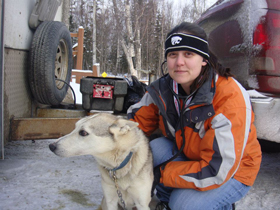February 26, 2013
Dog's best friend: University veterinarian on trail of Iditarod job
Submitted by Communications and Marketing

With one Iditarod Trail sled dog race under her belt, Kansas State University's Stephanie Oursler hopes one day to play an even more vital role in the grueling race from Anchorage to Nome, Alaska.
In 2012, Oursler, a research associate in clinical sciences at the College of Veterinary Medicine, braved the cold of Alaska to be a veterinarian trail assistant at what some call the "last great race." This year's race starts March 2 with teams competing to be the first to cover the roughly 1,049 miles between Anchorage and Nome.
"To be eligible to be a trail veterinarian you must be out of veterinary school for five years and sled dog experience is preferred," Oursler said. "I helped with the pre-race exams in order to gain experience and hope that in 2017 I'll be able to submit an application to be a trail vet."
The pre-race exams include blood collection and analysis, microchipping and electrocardiograms on all dogs set to participate in the race. Oursler not only worked at the pre-race exams, but also the ceremonial start and official start, making sure the mushers brought the correct dogs and that any last-minute concerns were addressed.
Dogs chosen to race in the Iditarod train throughout the year and must run in a variety of races prior to the big event to be eligible to participate.
"These dogs love to run," Oursler said. "That helps make the race not so terribly hard on them."
At the race, mushers were attentive to their dogs and did not hesitate to drop a dog off at a checkpoint when necessary, Oursler said. Mushers are allowed to bring 24 dogs to the pre-race exams. They then pick 12 to 16 dogs to race based upon the results of the pre-race workup. However, they must finish with a minimum of six dogs. No dogs can be added once the race has started.
At each checkpoint along the race, veterinarians check the sled dogs. Physical exams are taken on all dogs, and more attention may be given to any dog a musher may have questions or concerns about, Oursler said. Veterinarians are specifically looking for any lameness, injuries or illnesses that need attention throughout the pack.
Last year was the third year in a row that there were no dog deaths at the race. Oursler believes it can be attributed to the pre-race physical exams and the careful attention of the mushers. Dehydration, stomach ulcers, lameness and frostbite are the most common problems seen during the race. She said there are many preventative measures in place to help decrease the incident of these conditions.
"I definitely want to be involved with the race again," Oursler said. "These dogs are amazing athletes and I loved working with them and their mushers."
